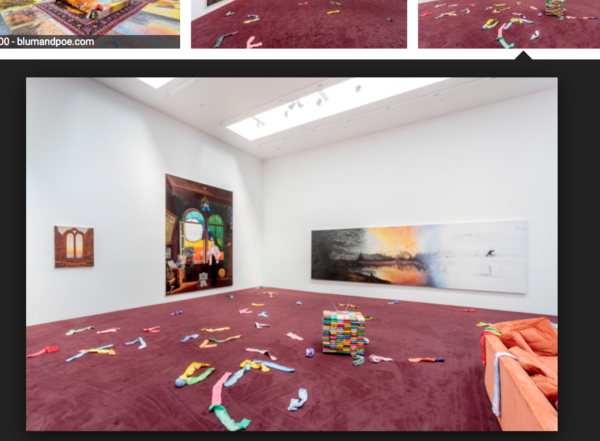It is winter break so I finally had some time to peruse GQ Style’s 2017 Holiday Issue. For me, GQ exudes cool in its ability to not only capture different waves of trends, but also acknowledge that waves break which makes room for new ebbs to form, especially when it comes to fashion and style.
In the holiday issue, I was introduced to an East Berlin-born painter, who resides in East L.A., Friedrich Kunath. If one had to describe Kunath’s style, it would be an eclectic iconoclasm of contemporary images and objects that have affected him throughout his life. While reading the article Friedrich Kunath’s East Angeleno Homesick Blues, by Arty Nelson, an art and food writer in Los Angeles, I was struck by Nelson’s description of Kunath’s studio as an in-process, “air-conditioned anxiety dream”[1] which was accompanied by a photograph shot by, Michael Schmelling, of what looked like a 21st century, Disney-fied Carl Andre work of a series of dyed multi-colored socks hung up with clothes pins in a very minimalist one-after-the-other style. The socks would go on to be used in Kunath’s installation at the contemporary art gallery, Blum & Poe, titled Frutti di Mare.
Socks are sometimes forgotten, and often time they are neglected in the category of “fashion”. Generally, Socks are worn out of need for warmth, or protection rather than for aesthetic desire. In Frutti di Mare, which means seafood, or more literally fruit of the sea, the colorful socks are used to evoke the idea of the domestic space in relation to the paintings exhibited in the gallery space. The socks in disarray challenge the integrity of the gallery space while also calling attention to the sense of pastiche that Kunath is trying to convey. Color in the installation space, is used subversively in an almost melancholic way to evoke the cliché around the common images that inundate the postmodern life. It is a postmodernist critique on postmodernity itself. Through the aestheticization of the banal, Kunath makes visible the senselessness in trying to make sense, through the romanticization of what surrounds us every day. The socks in the space, have no exact pair, each wanders in search of meaning. The socks, in a way, represent the ideal postmodern subject: the lover in the way the lover tries to make sense himself without the loved object. In the end, the socks turn out to subvert the minimalist aesthetic of order and rationality while calling attention to a desire for it without satisfying it.
By Destinee Forbes
[1] Nelson, Arty. “Inside Friedrich Kunath’s Amazing World of Sublime Art, Classic Cars and Obscure Scents.” GQ, GQ, 27 Nov. 2017, www.gq.com/story/inside-artist-friedrich-kunaths-amazing-world.


